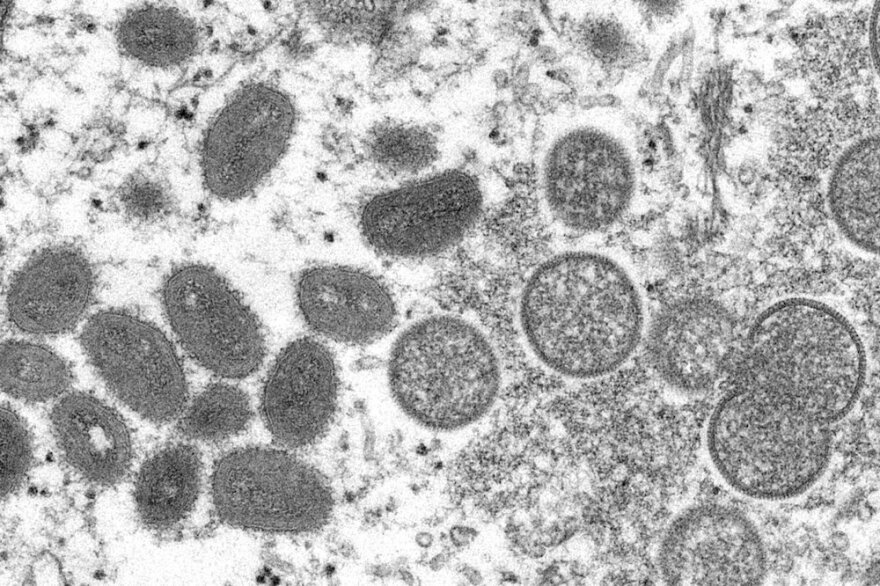ALLENTOWN, Pa. – Cases of monkeypox, the infectious viral disease that has become a global concern, are still popping up. There now are more than 68,000 cases in the world, with 24,000 of those in the United States.
As those cases rise, and more is understood about how the virus is spread and treated, comparisons to the AIDS outbreak in the early 1980s are also becoming more frequent.
- There now are more than 68,000 cases in the world, with 24,000 of those in the United States
- Two Lehigh Valley doctors discuss what it was like to treat patients back when AIDS first popped up in the country versus treating monkeypox patients.
- Health experts say prevention and treatment are key to stopping the spread.
Stigma
Dr. Jeffrey Jahre, senior vice president of medical and academic affairs at St. Luke’s University Health Network, said the fact that our advanced westernized country has the most cases right now is particularly damning.
Both Jahre and Dr. Luther Rhodes of Lehigh Valley Health Network were practicing infectious disease specialists during the AIDS epidemic in the 1980s, and now are seeing patients through the monkeypox outbreak.
But the lessons learned through AIDS also are helping in dealing with monkeypox, health officials say.
Personal experience
Jahre said that his experience through the outbreaks of the diseases is similar.
“I have a sense of frustration and disappointment,” Jahre said. “In the early days of both AIDS and, obviously, what we're dealing with with monkeypox is the same type of feeling – that patients have frustration and disappointment in the beginning was that it wasn't enough for HIV, there wasn't enough government interest or work being done on preventative cures.”
Rhodes said, “the initial HIV outbreak brought with it fear, some anger, a lot of anger, confusion and some stigmatization, which was unfortunate.”
“But we worked through that, I think largely,” he said. “It took a while, but we worked through it. We also learned how poisonous it is to blame individuals or groups for disease.”
In addition to the two seasoned physicians, Chyrsan Cronin, the public health director at Muhlenberg College in Allentown, weighed in on the topic.
"I think a lot of people weren't even around in the ’80s and so they don't remember that uncertainty and fear and the level of death that was surrounding us from this disease that we didn't really have an understanding about,” Cronin said.
“We've come such a long way in 40 years and being able to genetically understand viruses and understand how they mutate, understand how we might prevent that mutation from occurring by educating people on how to protect themselves from being infected in the first place."
Different viruses
Cronin, Rhodes and Jahre stressed that AIDS and monkeypox are very different.
“They're definitely different to different viruses, different treatments, different preventions,” Rhodes said. “But they do have in common some behavioral changes that reduce your risk of becoming infected with either virus.”
“When we speak about AIDS, we're talking about three major modes of transmission, and that is by blood, by sex and also from mother to baby,” Jahre said.
“Whereas with monkeypox, what you absolutely need is prolonged intimate contact with either respiratory secretions or contact with the actual lesions of monkeypox."
Though different, HIV and monkeypox are found mostly in men who have sex with men.
Cronin said people are taking what was learned during the HIV epidemic and applying it to monkeypox.
“Knowing how it was spread, in a survey, at least in United States of men who have sex with other men, over half of them said that they stopped having sex with multiple partners or they stopped having sex with people they met on websites for now,” she said.
Jahre added that people should be cautious right now when it comes to sexual activities with multiple partners.
“If you're monogamous and both individuals are monogamous it doesn't matter what your sexual orientation is, you're not going to get this disease," he said.
The health experts each discussed the stigma that comes with these diseases that affect a specific group — in this case, men who have sex with men.
They say in the ’80s, that stigma hurt the chances of controlling HIV because many had the mentality that it would not affect them specifically, so it was ignored.
Now, they stress the importance of letting people know who is at risk, without adding a negative connotation.
“These diseases, even though they started in certain risk groups, there's nothing that confines it to those risk groups,” Jahre said.
Meanwhile, Rhodes said he believes that this time around, social media is helping to get facts out to those at risk.
“There are voices within the gay community who have said up right, ‘Don't be, don't overdo the fear of stigmatization, because we need to focus our resources on the at-risk group,’” he said. “I think that message has been better conveyed with monkeypox than it was in the first, say, the first half of the 1980s.”
Cronin said, “I think because it was an identified and applied population that has already been through this rodeo one time with HIV, that individual precautions were taken much more seriously to prevent the spread.”
Treatment, prevention
All three of the health field professionals say prevention is the key to controlling any disease.
The advantage the medical community has now to fight monkeypox is a vaccine, which they did not have for HIV. On the other side, there now are treatments for HIV that can keep the illness subdued, while doctors still are researching that same type of treatments for monkeypox.
Rhodes said those who are at risk and believe they’ve been exposed to either virus should get tested.
“Testing now is much, much more available and can be done basically through your doctor's office or through any public health outlet,” he said.
Cronin said Muhlenberg College has information about monkeypox available to students.
“We haven't had a case that I know of on campus, but we do have a reporting system for that, if that should happen,” Cronin said. “We have protocols in place and that is the student will be sent home for two to four weeks until the blisters scab over and they're no longer considered infectious."
"I'm hoping that maybe at this point in time, that the lessons that we could have learned from HIV or AIDS, and certainly the ones that we are now learning from monkeypox, can be applied to the next pandemic, which is certain to come.
“And if we don't, then shame on us."


